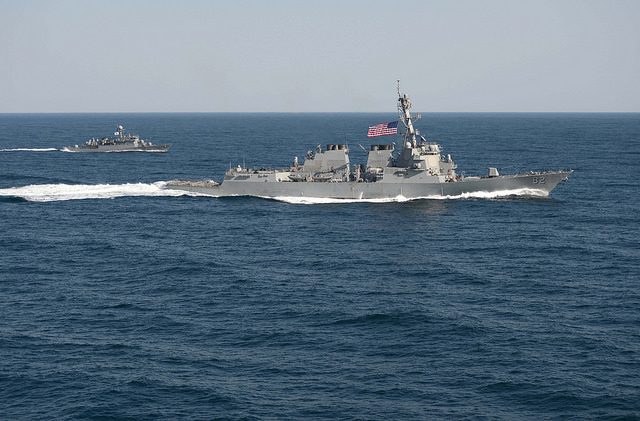SUMMARY
This is AI generated summarization, which may have errors. For context, always refer to the full article.

BEIJING, China (2nd UPDATE) – The United States defied China Tuesday, October 27, by sending a warship close to artificial islands the rising Asian power is building in disputed waters, prompting Beijing to furiously denounce what it called a threat to its sovereignty.
The USS Lassen, a guided missile destroyer, passed within 12 nautical miles – the normal limit of territorial waters around natural land – of at least one of the formations Beijing claims in the Spratly Islands.
Washington’s long-awaited move to assert freedom of navigation in the South China Sea also escalated the dispute over the strategically vital waters, where Beijing has been transforming reefs and outcrops into artificial islands with potential military use.
China claims sovereignty over almost the whole of the area, raising concerns it may one day seek to dictate who may transit its bustling sea lanes.
Several neighboring countries including the Philippines, a US ally, have competing claims and the dispute has raised fears of clashes in an area through which a third of the world’s oil passes.
The US action was part of the country’s “routine operations in the South China Sea in accordance with international law”, an American official told Agence France-Presse. “We will fly, sail, and operate anywhere in the world that international law allows.”
China’s foreign ministry spokesman Lu Kang blasted the exercise, saying that the ship “illegally entered” the waters near the islands “without receiving permission from the Chinese government”.
Beijing “resolutely opposes any country using freedom of navigation and overflight as a pretext for harming China’s national sovereignty and security interests”, he said, adding it would “staunchly defend its territorial sovereignty”.
Balance of power
There have been repeated confrontations in the area between Chinese vessels and boats from some of its neighbors, particularly the Philippines and Vietnam.
Both are members of the Association of Southeast Asian Nations (ASEAN), which has long called on China to negotiate a code of conduct in the region, as are fellow claimants Brunei and Malaysia. Taiwan also asserts rights to the waters.
Manila has infuriated the world’s second-largest economy by taking the dispute to a United Nations tribunal, and Philippine President Benigno Aquino III said the US action demonstrated that “the balance of power says that there is not just a single voice that must be adhered to”.
Beijing’s South China Sea reclamations have been seen as an attempt to assert its claims by establishing physical facts in the water, but Aquino said: “There is no de facto changing of the reality on the ground.”
Beijing has repeatedly said the construction work is primarily for civilian purposes, and Chinese President Xi Jinping during a visit to Washington last month pledged that the country will not militarize the area.
But satellite images of the islands published by the Washington-based Centre for Strategic and International Studies show that Beijing has reclaimed millions of square meters of land in the Spratlys, known as Nansha in Chinese.
The pictures also show a host of facilities with the potential for military applications being developed, including as many as 3 runways, at least one of them 3,000 meters (10,000 feet) long.
‘Long overdue’
The US, which is engaged in a foreign policy “pivot” to Asia, and China, which has the world’s largest military and is expanding the reach of its navy, are jockeying for position in the Pacific.
Beijing regularly calls for a “new model of major country relations”, implying equality between the world’s top two economic and military powers.
Tuesday’s operations were “not directed at any specific country,” the US official said.
“US forces operate in the Asia-Pacific region on a daily basis, including in the South China Sea,” he added.
The sail-by was “long overdue”, said Bonnie Glaser, a senior China expert at CSIS, adding that the exercises “should be done quietly, regularly, and often”.
“There should be no media fanfare,” she added. “The way this has been handled has left the Chinese believing that the US is challenging its sovereignty rather than simply exercising freedom of the seas.” – Rappler.com
Add a comment
How does this make you feel?
There are no comments yet. Add your comment to start the conversation.